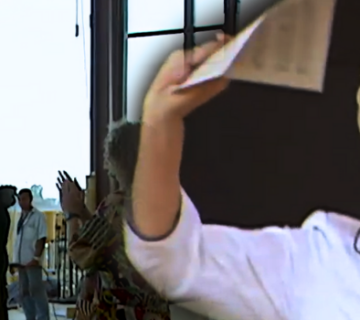
«We are all here in front of the very beautiful image of Our Lady of Guadalupe which was painted in heaven, first of all, out of love for the very beloved Mexican people.
Like you, I too ardently wished to come here after learning more about this very sweet Mother of God and our Mother, and after reading the story of Our Lady of Guadalupe which surprised me and moved me.
What do we feel in our heart after this heavenly contact in which we contemplated the great privilege that the world, and first of all Mexico, received through the apparition of our sweet Lady? A deep conviction easily surfaces in our soul: Our Lady of Guadalupe has much to do also with us, with the Focolare Movement, the Work of Mary.
Why do I say this? Because Our Lady of Guadalupe is the Madonna of love, and love is the very essence of our spirituality. Our Lady of Guadalupe indeed manifests, explains, and teaches, in a sublime way, that art of loving which we have understood in the Gospel. We know that supernatural love has very precise demands: Above all, this love requires that we love everyone. This love asks that we do not allow ourselves to be conditioned by whether people are pleasant or unpleasant, beautiful or ugly, fellow countryman or foreigner, Asian or African. The love which Jesus brought on earth requires that we love everyone.
And what did Our Lady of Guadalupe do? She gave an extraordinary example: she loved the indigenous people and the Spaniards. Furthermore, true love demands that one take the initiative in loving, as Jesus did. He gave his life for us when we were still sinners. This is what the heavenly Morenita did. Unexpectedly, she appeared to an indigenous man and thus underlined, among other things, Jesus’ preferences. In times when the indigenous people were living their terrible Good Friday, she did not appear to a member of the dominating part of the population, but to an indigenous man, speaking his language. And she didn’t only appear, she brought about relief and happiness, and with heavenly sweetness she led millions of people on both sides to convert to her son, Jesus.
Supernatural love certainly doesn’t nourish itself on sentiments, or on a bit of good will, or just on solidarity, or almsgiving. It is that love which Jesus himself has borne witnessed to, by making himself one with us in the incarnation, and then in his passion and death. Another attribute of love is indeed knowing how to make ourselves one with others in order to understand them, and to share their joys and sufferings. It is this attribute of love, this making ourselves one, that substantiates inculturation, which is so very much needed today, and which the Church strongly emphasizes in order to offer an authentic evangelization.
Mary of Guadalupe is really the Mother of true love, the Mother of knowing how to make ourselves one. Our Lady of Guadalupe is an extraordinary and wonderful example of inculturation, which she expressed in the way she appeared. She did not have a white countenance as Mary of Nazareth is depicted; her features are those of a woman who is a “morena,” neither white nor indigenous. She is “morena,” and thus preaches to all the need not to ever clash, but always to come together. She shows her divine maternity, symbolized by the dark ribbons which hang down from her chest, as was the Aztec custom. By wearing a dress reserved for God and for the king, she wants to demonstrate that although she is not of divine origin, she is the queen of the universe. Next to the black ribbons, she has a small Indian cross to indicate that the center of the universe is Christ whom Mary is carrying in her womb. That cross, however, is accompanied by a small Christian cross engraved in the brooch she wears at her neck.
Her image highlights the presence of the sun behind her, with the stars on her mantle and the moon beneath her feet: the sun, stars and moon are not opposed to one another as people thought; rather, they co-exist in peace.
And we could go on and on…. As Mexicans, you would have many more things to tell us. What I have mentioned, however, seems sufficient to help us understand something very important: inculturation doesn’t only mean to make ourselves one with another people spiritually, discovering and perhaps potentiating the seeds of the Word present in them. It also means to receive, with humility and gratitude, valid elements that the culture of our brothers and sisters have to offer. Inculturation demands an exchange of gifts. This is what Our Lady of Guadalupe wants to tell us. Only in this way will the Gospel be able to penetrate into the depth of our souls and bring about its revolution, with all its consequences».
Chiara Lubich, Guadalupe, June 7th 1997


 Italiano
Italiano Español
Español Français
Français Português
Português


